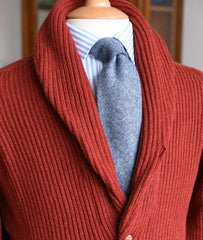Men’s style writer and photographer Lee Osborne heads to West Yorkshire for a behind-the-scenes insight into the weaving of Shetland wool.
Fly me to the Moon
“Fly me to the Moon'' sang Frank Sinatra, “and let me play among the stars”. For any self-confessed man of the cloth like me, a trip to the hallowed ground of Abraham Moon & Son instead affords the opportunity to “play among the yarns” of one of Great Britain's last remaining vertical woollen mills.

Based in the picturesque town of Guiseley, with its blackened-by-industry stone buildings, it’s historically part of the West Riding of Yorkshire, situated south of Otley and Menston and now a bona fide north-western suburb of the City of Leeds
Ever since the company was established back in 1837, towards the latter stages of the Industrial Revolution (the very same year Queen Victoria succeeded to the British throne) lorry loads of shaggy-looking raw wool have been beating a path to the doorstep of Moon’s mill in readiness to be crafted into metres of wondrous cloth of all descriptions, with each and every process completed on-site.

THE PROCESS*
RAW WOOL
In order to craft its luxury fabrics and help maintain its reputation, Moon’s demands the best available natural raw materials. Their Shetland quality Pure New Wool is imported from as far afield as New Zealand and delivered in its raw state to Moon’s site in Guiseley where it’s either scoured or cleaned and combed broken tops, which ensures there are less than 0.3% impurities within the fleeces. Quality starts on the farm; sheep reared on a different diet can affect the quality of the raw material so it’s imperative they buy their wool from reliable sources.
DYE HOUSE
BLENDING

CARDING
The process of carding is essential in producing soft, smooth fabrics. The blended wool is lubricated with a little water and oil is run through a series of combed rollers that first tease the fibres one way and then the other. This process rids the wool of any lasting impurities, ensuring the finished fabrics are smooth and retain a soft hand feel. Carding also helps with alignment and uniformity. At the end of the process, the combed and teased fibres are wound onto a spool ready to be placed into the spinning machine.
SPINNING YARN

WARPING

WEAVING

This is where many different yarns are woven together in intricate weaves to create stunning fabrics. Moon’s uses automatic Rapier looms to take the weft (horizontal thread) across the warp threads, which are capable of weaving 30,000m of cloth per week. After the fabric is woven, each piece begins a strict quality control process. Every inch of fabric is inspected at three stages in the manufacturing process – when it comes off the loom, after finishing and again before it leaves the factory - ensuring their trademark consistency in quality.
SCOURING, MILLING, & FINISHING

How to style it
I’ve picked this sky blue and white cotton Bengal Stripe shirt from the Amidé Hadelin Orange Label collection to create 3 stylish colder clime looks utilising Shetland accessories:
-
Rust Geelong shawl collar cardigan + Steel blue Abraham Moon Shetland tweed tie

No sartorially-savvy gent should be seen without a shawl collar cardigan in his armoury. Originating from the 1920s, the ribbed-knit crafted in the Scottish Borders combines the neck of a smoking jacket and the body of a cardigan and was adopted by silver screen icons Steve McQueen and Daniel Craig decades later. It’s a great alternative to wearing a sports jacket or blazer, and what’s more, you can still wear a tie and braces. For staving off the chill, menswear simply doesn’t come more comfortable and stylish than this.
-
Green Fair Isle lambswool sleeveless cardigan + Loden green Abraham Moon Shetland tweed tie

Fair Isle, for those unaware, is a remote island situated between Orkney and Shetland which has historically lent its name to an item of knitwear which remains a staple of the classic menswear wardrobe. Its unique knitted style, where two or more colours repeat continuously across a row is great for layering and adding colour and texture to an outfit. Legend states that Spaniards, stranded on the island after the break up of the Spanish Armada in 1588, taught the islanders to use the colours and patterns typical of Fair Isle knitting. The nature of the Fairisle knit is visually busy enough in itself so a simple textured Shetland tie in Loden green makes for a wonderful AW look.
-
Brown Abraham Moon houndstooth check Shetland tweed braces + Tan brown Abraham Moon Shetland tweed tie

It is believed the first known "suspenders" originated in eighteenth-century France. Back then they were basically lengths of ribbon or leather attached to a pair of trousers. The first modern braces were in fact manufactured by Albert Thurston in 1820 and sold from his fashion emporium in London's Haymarket. Braces are still alive and kicking in 21st-century menswear and these houndstooth examples are a fun way of adding texture to more neutral-coloured sports jackets and suiting - particularly corduroy - topped off by this exquisite tan-coloured tweed tie.
*Information gathered courtesy of moons.co.uk

Lee Osborne spent 10 years working on luxury travel and lifestyle magazine Condé Nast Traveller where he was Creative Director before establishing his own luxury content studio, Osborne Creative. A frequent traveller, he is founding editor of men's style blog Sartorialee: dressing the globe-trotting man, and regular contributor to The Rake, Plaza Uomo, The Daily Telegraph and Harrods magazine.
Follow Lee Osborne on Instagram @sartorialee and explore https://sartorialee.com/ for more travel and style inspiration.

